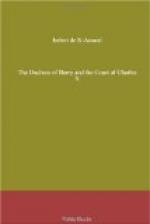The government of Charles X. protected Meyerbeer as well as Rossini. Robert le Diable was only played under the reign of Louis Philippe, but the work had already been received under the Restoration.
During the reign of Charles X. the fine royal theatres reached the height of their splendor: the Francais and the Odeon were installed in their present quarters; the Opera in the hall of the Rue La Peletier, excellent as to acoustics and proportions; the Italiens in the Salle Favart (where they remained from 1825 to 1838); the Opera Comique in the Salle Feydeau, until the month of April, 1829, when it inaugurated the Salle Ventadour. Talma, Mademoiselle Duchesnoir, Mademoiselle Mars, triumphed at the Francais; Mademoiselle Georges, at the Odeon; Nourrit, Levasseur, Madame Damoreau, Taglioni, at the Opera; Sontag, Pasta, Malibran, and Rubini at the Italiens.
The Viscount de la Rochefoucauld wished in every way to raise the moral level of the theatre. He forbade subscribers, even the most influential, the entree behind the scenes of the Opera, because these persons had not always preserved there the desirable decorum. Thence arose rancor and spite, against which he had to contend during his entire administration. He wrote to the King, July 29, 1828:—
“A cabal is formed to deprive me of the direction of the theatres; and by whom and for what? It is a struggle, Sire, between good and evil. It is sought to maintain, at any cost, the abuses I have dared to reform. They throw a thousand unjust obstacles in my way. Gamblers are mixed up in it too; they wish to join this ignoble industry and the theatres. It is a monstrous infamy. The opera must be reached at all hazards, the coulisses must be entered; these are the abuses that must be revived. How can it be done? By removing the theatres from troublesome authority ... Sire, Your Majesty shall decide, and must defend me with a firm will in the interest, I venture to declare, of order; you must defend yourself also in the interest of morals and of art, and of a great influence of which it is sought to deprive you.”
M. de La Rochefoucauld had the last word, and remained at the head of the direction of the Fine Arts until the close of the Restoration. To the credit of his administration there must still be added the creation of the school of religious music, directed by Choron, and the foundation of the concerts of the conservatory with Habeneck, and a little against the wishes of Cherubini. The chefs-d’oeuvre of German music were brought out as well as those of Italian music. The Viscount performed his task con amore, as they say on the other side of the Alps. He wrote to Charles X. January 12, 1830:—
“How many reflections must have come to the King on regarding the picture of the Coronation! I divined the thought that he did not complete, and my eyes filled with tears. Oh, how much I feel and imagine all the ennui given to the King by these barren and unfortunate politics! I detest them more even than the King detests them. Ungrateful offspring of the times, they fly away, rarely leaving even a memory. How much I prefer the arts!”




